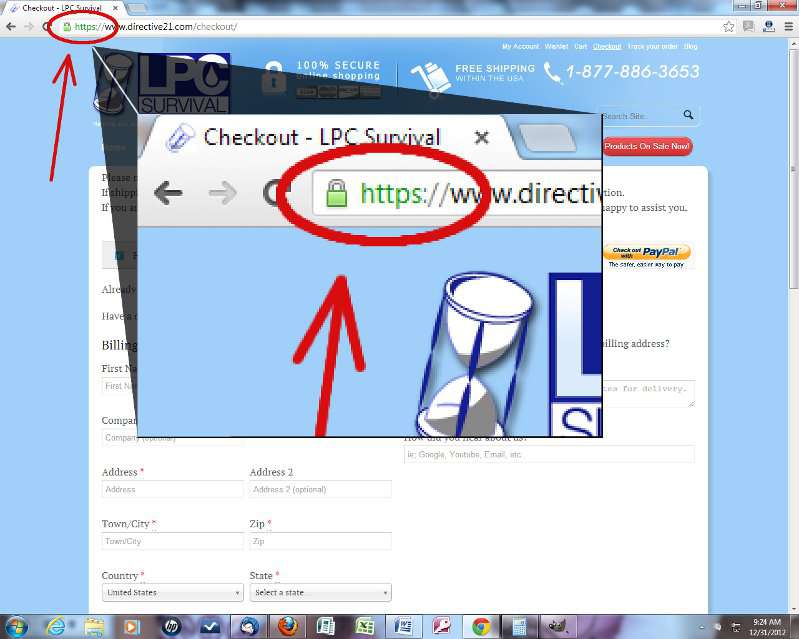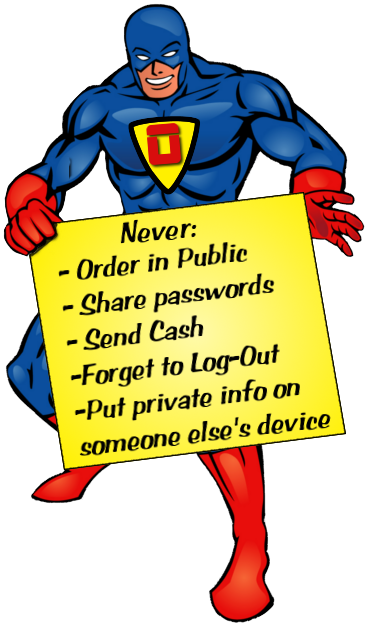Okay, I just returned from my punishment of 1,000 lashings for not finishing this series on time…funny thing is that one of the reminder requests was from a link-posting service trying to get a free link-back that they were waiting for the remaining articles. Thanks for your patience and for not burning down the interwebz.
Now, without further ado, here is part 4 of the 6-part series:
One of the most common concerns with folks who are not comfortable purchasing online is the whole idea of “is it safe to purchase on this website?” We definitely cannot speak for any other company than our own & even so, there is a tough reality to any activity you & I will undertake as consumers: virtually NOTHING is safe. That’s right! Now, I don’t mean to add to any paranoia out there, but it’s a cold hard fact. As far as ordering securely from an online company, I only know of three options for purchasing:
- Order on a site securely via a payment portal with a valid SSL certificate (https:// or lock icon, see image below)
- Phone-In your order to the Company & pay via Credit Card.
- Call & speak with one of the Company’s Customer Service Representatives. Obtain the address where you might mail a check, cashier’s check, or money order.
Order on a Site Protected with SSL
SSL (“Secure Socket Layer”) is a layer protection that ensures that your payment information will only be viewable from you and the merchant. SSL is indicated in the “http…” portion of the website address. A site with SSL will have an “s” in it like this: https://www.directive21.com. At times, you may only see the SSL on the actual checkout or payment page and that is what you want. The secure padlock (see image below) does not have to be colored as the image displays but the lock itself is a reliable indicator when paired with the “https://…”.

Phone –In Your Order
Many people do not like entering their orders online themselves. Some of them distrust technology; others prefer the personal interaction that comes with speaking to someone over the phone; some just don’t have the time or resources to order themselves. In every one of these scenarios, phoning-in the order is another solution to keep things secure. When it comes to providing a credit card number during the payment part of the transaction, every once in a while one of our customers will request a partial credit card number & then call back with the remaining information. Their thought is that if anyone is listening in on the phone conversation, the break in communication will add another layer of theft/identity fraud prevention.
Mail-In Your Order & Payment
Many of the younger generations now in school and not readily spending consumer-dollars yet are unfamiliar with mail-in ordering. I would estimate that roughly 5% of our customer-base prefers this method of ordering & paying for their purchases. We are happy to accommodate these requests and always remind customers to speak with us over the phone first & be sure to include:
- Contact information (phone number, email address) along with correct shipping address,
- Details of the order such as specific quantities & product name(s) or part number(s), item price, & any notes on discounts or coupon codes,
- Payment!
When sending payment, it is crucial to create a layer within the envelope that will prevent a check from being recognized and then stolen. Never send cash. When sending payment, I always mail it certified mail & with confirmation. This doesn’t prevent anyone from stealing it, but it does give me recourse for records in the event theft does occur.
Once you’ve placed your order, always obtain a “transaction confirmation number” or “order number”. These numbers are merely specific reference codes that will allow any customer service rep at the company to help you & locate your order without having to search with limited information. The truth of the matter: have your references lined up. It will save you time & make life easier for everyone when/if you have to call to inquire about your order.
- Manually write down your confirmation number in a safe location where you can easily access your reference.
- Save a printed copy of your receipt from the screen or print it out from your confirmation email.
- Remember that your credit card statement should reflect the charge for your purchase & use that as a back-up method for documentation & protection.
A word about credit cards/bank cards: If the time ever comes that you need to dispute a transaction, you should attempt to contact the merchant directly before doing anything else. Reach out via email, call customer service, or go into the retail location (if possible). Customers frequently forget their purchase and when reviewing their statements they might forget the transaction & mistakenly initiate a charge-back to the merchant. Such disputes often unnecessarily cause the merchant to lose money to additional fees & reflect poorly on them with their merchant transaction service. Use common courtesy for what might simply be a mistake instead of “jumping the gun”. Such small mistakes are usually quickly resolved with a simple conversation between parties, especially from established companies that service thousands of customers like us.
 To summarize (just look at Captain Obvious)…&
To summarize (just look at Captain Obvious)…&
- • Order from Secure Payment Portal
- • If in doubt, Call & Speak with a Live Person
- • Mail-In Orders & Payment is not Out-Dated
Part 5 on Wednesday: Understand delivery times







Just a fair warning–calling in a card number over the phone is extremely unreliable, whether it’s because there are people on the other side of the phone that can rather anonymously steal numbers and resell them (like servers at restaurants), or because it’s easy to interupt phone calls and therefore listen in and steal card numbers. This happened to me so I hope others understand a phone call is risky too, maybe more than reliable internet sites.
You’re right; calling in a card number can be risky if done in an environment that is vulnerable such as a public setting. That is why we recommend folks to deal with companies that are established, have excellent referrals, & a well-known track record of satisfied customers. Thanks for sharing your thoughts!
-David